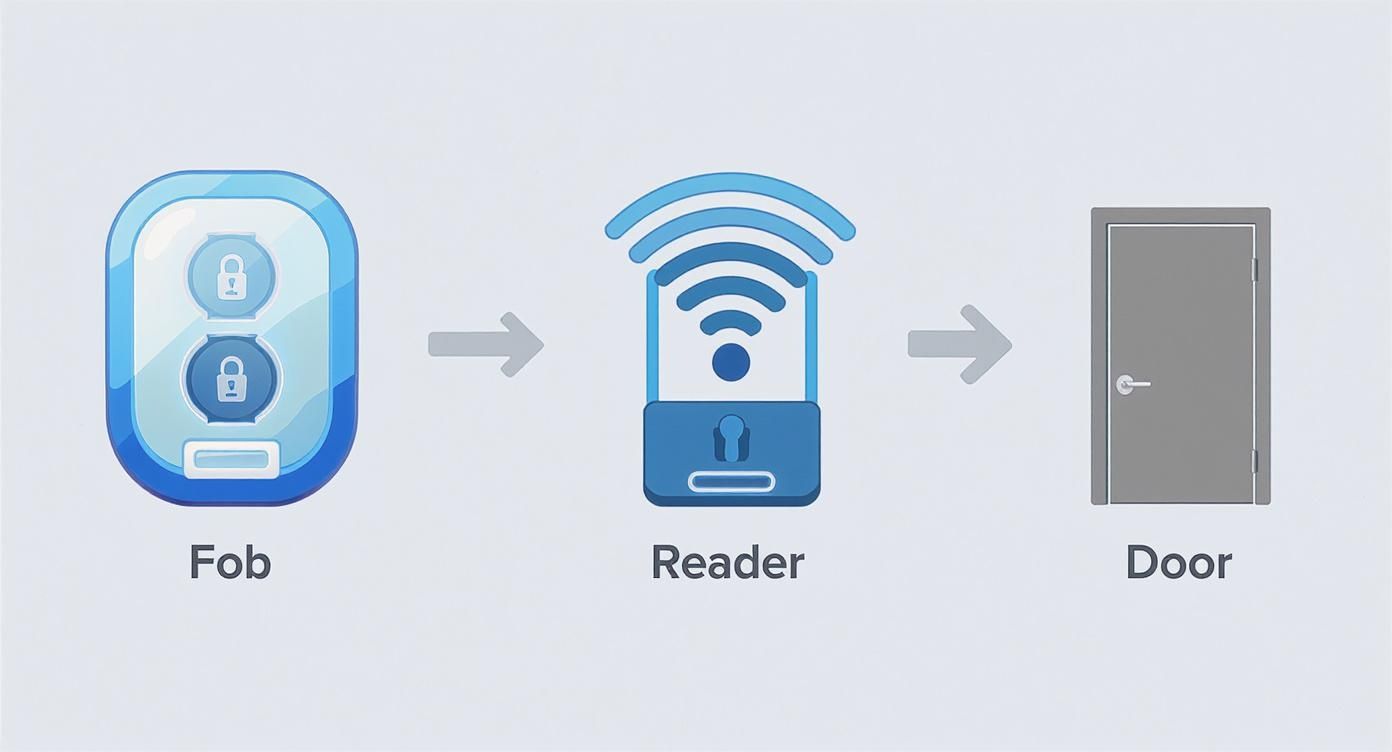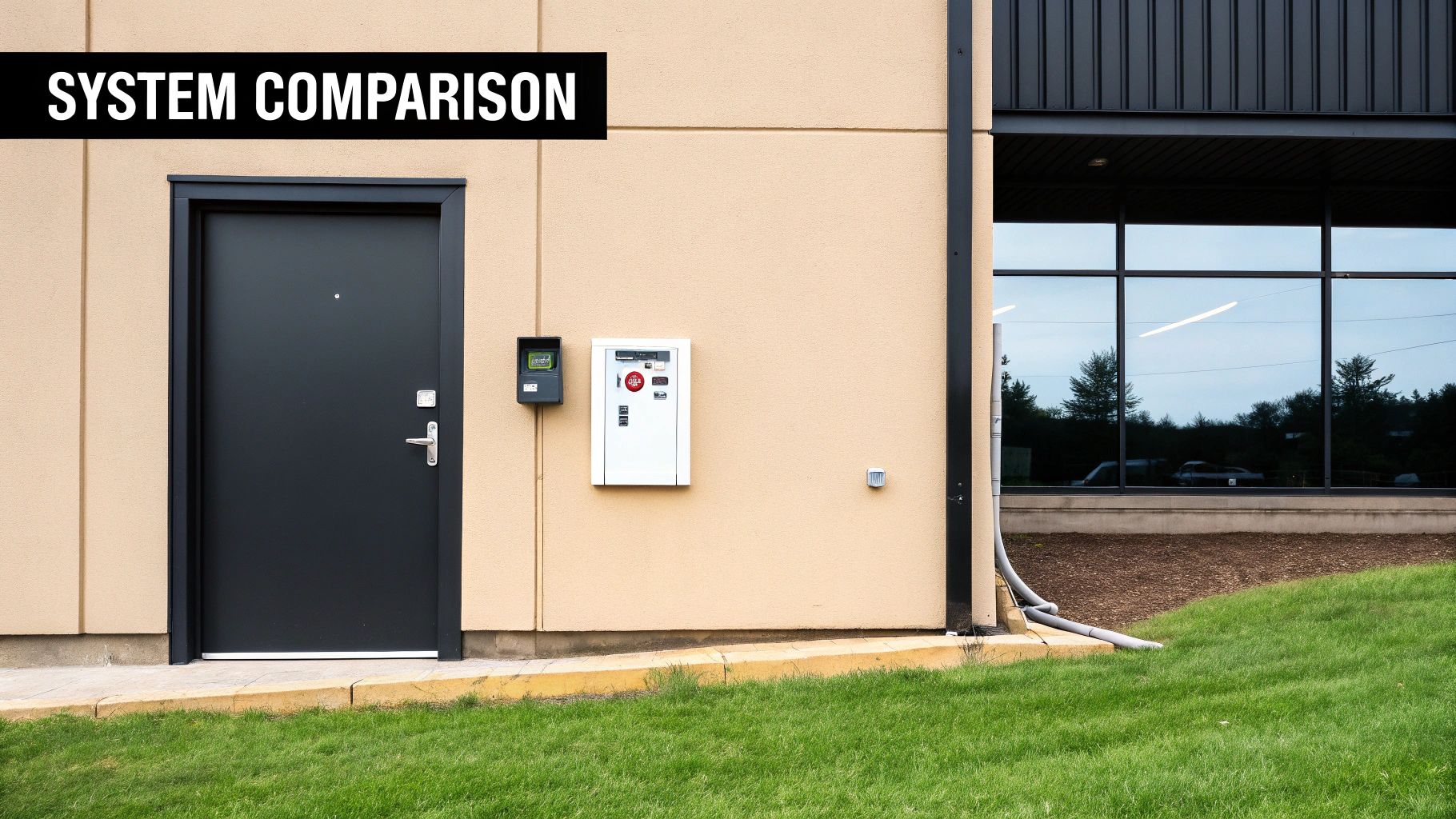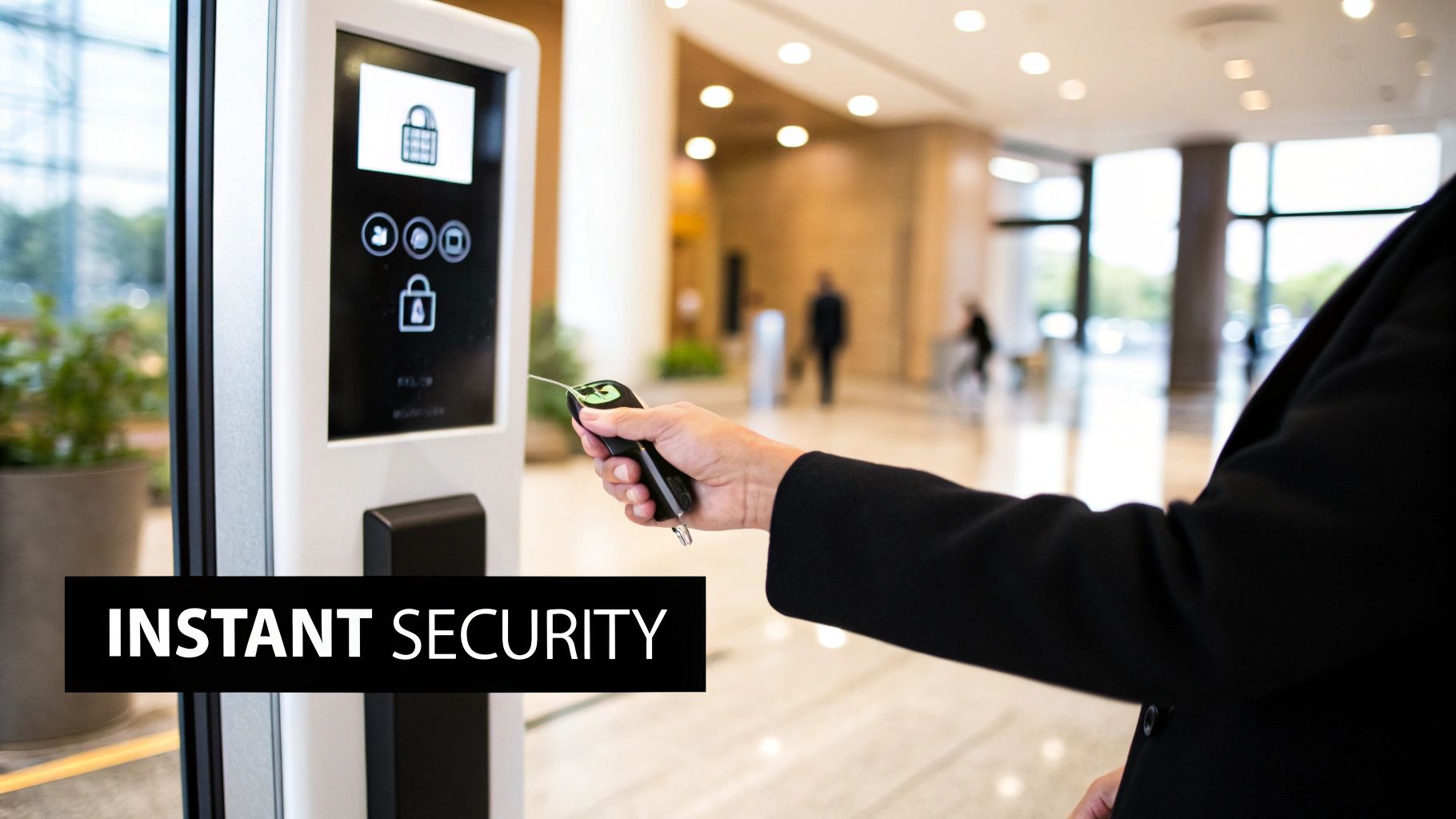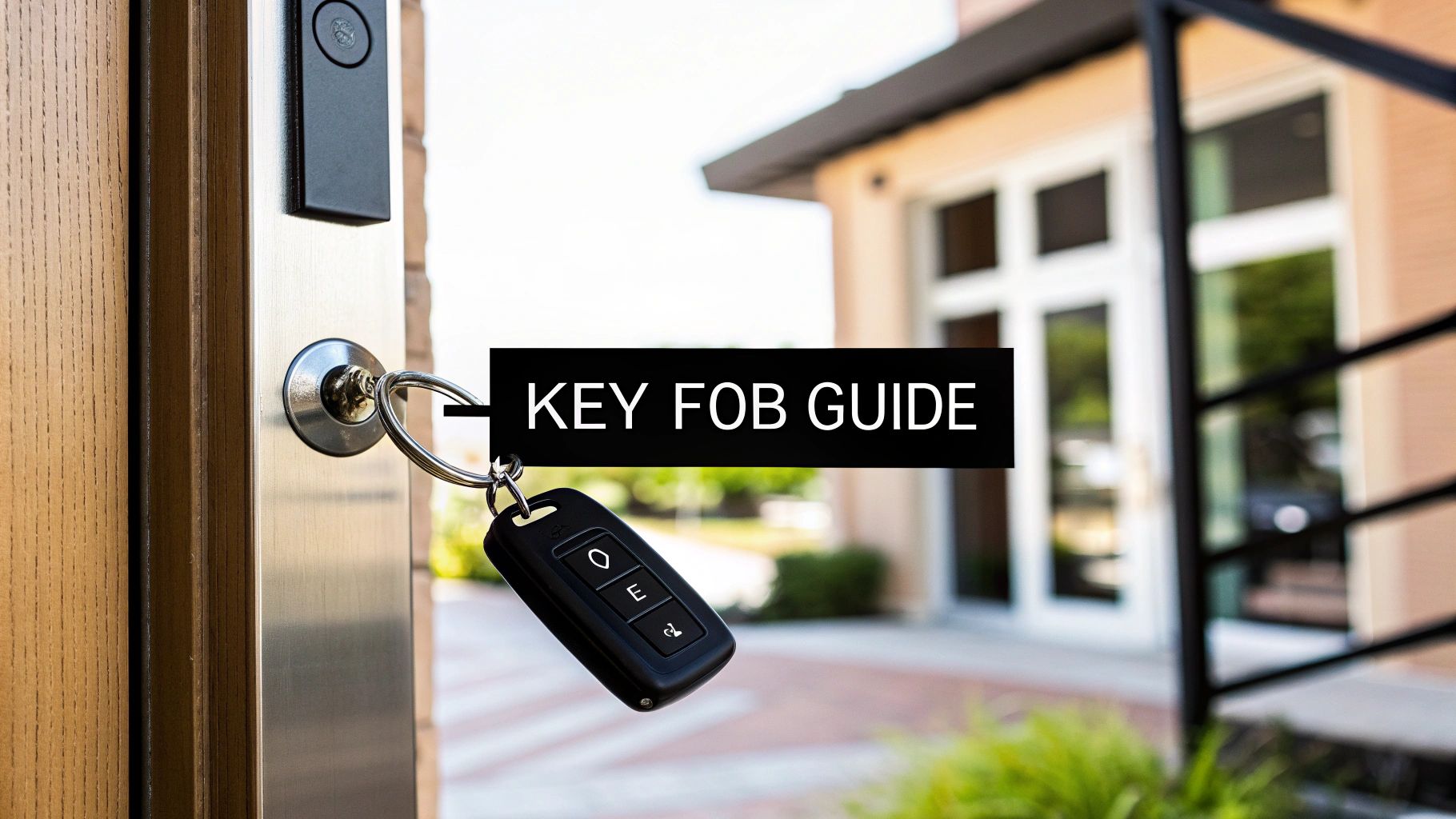If you've ever traded in a flip phone for a smartphone, you'll understand the jump from a traditional lock to a key fob entry system. It's not just a minor upgrade; it's a fundamental shift in security, convenience, and control. These systems are quickly becoming the new normal for modern buildings, leaving old-school metal keys in the dust.
Unlocking Modern Access Control
Think of a key fob entry system as a smart, digital bouncer for your property. Instead of a piece of metal cut into a specific shape, access is granted using electronic credentials. This one change solves the timeless headache of lost, stolen, or copied keys—a problem that can rack up thousands in rekeying costs and leave gaping security holes.
For any property trying to stay current, whether it's a busy apartment complex, a hotel, or a corporate campus, ditching outdated locks is a must. The power to grant or revoke access instantly from one central dashboard gives you a level of command over your building that was unimaginable with metal keys. We dive deeper into how this is changing residential living in our guide to smart locks for apartments.
The Core Components of Key Fob Entry Systems
Every key fob system relies on three key players working together seamlessly. You can think of them as a coordinated security team: the credential, the reader, and the controller. Getting to know their roles is the first step to understanding how powerful these systems truly are.
-
The Key Fob (The Credential): This is the small, portable device you hand out. Inside is a microchip and an antenna holding a unique, encrypted digital ID. It’s essentially a person’s digital key.
-
The Reader (The Gatekeeper): Mounted by the door, this device sends out a constant radio-frequency field. When a fob gets close, the field powers up the fob's chip and reads its unique ID.
-
The Control Panel (The Brain): This is the central command hub where the magic happens. The reader sends the fob's ID to the control panel, which checks it against an approved user list. If the ID has the right permissions for that door at that time, the panel signals the lock to open.
This entire digital handshake—from fob to reader to control panel—happens in less than a second. It creates an entry experience that feels effortless but is backed by robust security. The system isn't just about opening doors; it's about intelligently managing who can open them and when.
How Key Fob Technology Actually Works
When you tap a key fob to a reader, it feels like magic. The lock clicks open in an instant. But behind that seamless experience is a rapid-fire, secure digital handshake that verifies your identity in less than a second.
The whole process is a quick, elegant sequence. This infographic breaks down the flow, from the fob transmitting its signal to the door unlocking.

As you can see, it boils down to three core steps: the credential (your fob) sends out its unique ID, the reader grabs it, and the control system gives the green light. It all happens in a flash.
The Role of Radio-Frequency Identification
The technology making this all possible is called Radio-Frequency Identification (RFID). The easiest way to think about it is like a very short, very secure wireless conversation. The reader, which is mounted by the door, constantly emits a radio wave, creating a small energy field around it.
When you bring your RFID key fob close, its tiny internal antenna soaks up that energy. This powers up the fob's microchip for just a moment—long enough for it to broadcast its unique identification number. The reader catches that number and zips it over to a central control panel to check if you're on the approved list.
A key fob doesn’t need a battery. It’s a “passive” device that only wakes up when it enters the reader’s energy field. This is why they are so reliable and require zero maintenance.
Low Frequency vs. High Frequency Fobs
Not all fobs are created equal. They generally operate on one of two radio frequencies, and each has its own strengths depending on what you need it for. Getting a handle on these differences is key to picking the right system.
-
Low-Frequency (LF) Fobs: These run on a 125 kHz frequency. Their signal is great at passing through materials like water or metal, but they have a very short read range—just a few inches. This makes them a solid, no-frills choice for standard door access where you have to be right next to the reader.
-
High-Frequency (HF) Fobs: Operating at 13.56 MHz, these fobs can transfer data faster and pack in more security features. They can store more information and typically use advanced encryption, which makes them much tougher to copy.
For a real-world example, you can see how a device like the Bft Mitto2b Bollard Remote integrates into a broader security setup. Because of their beefed-up security, high-frequency fobs have become the backbone of most modern key fob entry systems.
The Rise of Mobile Credentials
Of course, the technology hasn't stopped at physical fobs. The latest systems are moving towards turning your smartphone into a key using Near Field Communication (NFC) or Bluetooth Low Energy (BLE).
This lets people simply tap their phone or even just walk up to a door to unlock it, which adds a whole new level of convenience. It's a major step forward when creating a complete access control plan for your business.
Not all key fob entry systems are created equal. The right choice for a small boutique hotel with a single entrance is worlds apart from what a massive, multi-building apartment complex needs. To pick the right one, you first need to understand the main players: standalone, networked, and cloud-based systems.

Each of these systems takes a different approach to granting access. The real difference comes down to how they're programmed, how the components talk to each other, and how much control you have from a single dashboard. Let's dig into what makes each one tick.
Standalone Systems: The Simple Solution
Think of a standalone system as a completely self-sufficient lock. All the brains—the list of approved fobs and the rules for entry—are stored right inside the reader itself. It doesn't connect to a network or a central computer.
This simplicity makes them a great fit for securing a single door, like a server room, a private office, or a storage closet. You program everything right at the door, usually using a special "master" fob to add or remove other fobs.
You can think of a standalone system as a digital deadbolt. It’s a straightforward and cost-effective way to secure one door, without needing complicated wiring or software. The trade-off? They don't scale well; managing more than a couple of these becomes a real headache.
Networked Systems: Centralized Control
Networked systems are a major step up. Here, all the door readers are wired together and connected to a central server that lives on your property. This server is the command center, holding all the user data and access rules in one consolidated database.
When you need to make a change—like revoking a former tenant's access—you do it once on the central computer, and the update is instantly sent to every relevant door on the network. This setup is built for properties with many doors, like office buildings, hospitals, and large residential communities.
A few key benefits really stand out with networked systems:
- Centralized Management: Add or delete users, set access schedules, and pull activity reports from one workstation.
- Real-Time Monitoring: You can see who is swiping their fob at which door, as it happens.
- Detailed Audit Trails: Generate comprehensive logs of every entry attempt, which is invaluable for security reviews.
Cloud-Based Systems: The Ultimate in Flexibility
Cloud-based systems are the modern evolution of access control. Instead of relying on a physical server tucked away in a closet on your property, all your data and management software are hosted securely online. This is a game-changer. It means you can manage your entire system from anywhere you have an internet connection—your laptop, your tablet, or even your phone.
This model gives you a level of freedom and scalability that on-premise systems just can't match. It’s become the go-to choice for property managers juggling multiple sites or for anyone who needs to manage access remotely. While they offer a high degree of convenience, they function quite differently from the more traditional options covered in our guide on door buzzer entry systems.
The biggest advantage is liberation from IT headaches. You no longer need to buy, install, and maintain a dedicated server. The cloud provider handles all the software updates, security patches, and data backups for you. This makes it incredibly simple to add new doors or even new properties to your portfolio with just a few clicks.
Comparison of Key Fob Entry System Types
To help visualize the differences, here’s a quick breakdown of how these three system types stack up against each other. Each has its place, and the best one for you depends entirely on your property's specific needs.
| System Type | Best For | Scalability | Management | Key Advantage |
|---|---|---|---|---|
| Standalone | Single-door applications like a supply closet, server room, or private office. | Very low; each door is an island managed individually. | On-site, programmed directly at the door reader. | Simple, low initial cost. |
| Networked | Multi-door buildings on a single property, like offices or apartment complexes. | High, but limited to the capacity of the on-site server. | Centralized on-premise server; manage everything from one computer. | Real-time monitoring and robust, centralized control. |
| Cloud-Based | Multiple properties, remote management needs, or businesses wanting to reduce IT overhead. | Virtually limitless; easily add doors or new locations. | From anywhere with an internet connection via a web portal or app. | Unmatched flexibility, scalability, and remote access. |
Ultimately, choosing between these systems comes down to balancing your current needs with your future growth plans. A standalone unit might be perfect today, but a cloud-based system could offer the flexibility you'll need tomorrow.
The Payoffs of Modern Access Control
Making the switch from old-school locks to a key fob entry system is about more than just a cool, modern feel. It’s a genuine strategic upgrade that delivers major wins in security, day-to-day operations, and the overall experience for tenants or guests. These systems give you a degree of control and insight that a metal key could never offer, transforming how you manage and protect your property.

The most obvious and immediate advantage is a huge leap in security. A standard key can be copied at just about any hardware store, but modern fobs are built with encryption, making them incredibly difficult to duplicate. Even better, if a resident moves out or an employee leaves, you can deactivate their fob from a central system in seconds. The security hole is plugged instantly.
Tighter Security and Clear Accountability
A game-changing feature of these systems is the audit trail. Every single time a fob is used—whether it’s a successful entry or a failed attempt—the event is logged. This creates a detailed digital history showing exactly who went where and when, which is priceless information if a security incident occurs.
With traditional keys, you're flying blind. You have no idea who entered a room or at what time. A key fob system gives you total visibility, turning every door into a data point that strengthens your security.
This kind of tracking is crucial for protecting sensitive areas and keeping everyone accountable. To really get the most out of it, many property managers pair their access control with comprehensive security systems monitoring for an even stronger defensive setup.
Smarter Operations and Lower Costs
Beyond the security boost, key fob systems make running a property much more efficient. Think about it: the expense and headache of rekeying locks every time a tenant leaves or a key goes missing? Gone. Instead of waiting for a locksmith, you can manage credentials with just a few clicks.
This simplified process saves a ton of time and money, especially for apartment buildings or hotels where people are always coming and going. Managing access for contractors, cleaning staff, or maintenance teams also becomes a breeze.
- Grant Temporary Access: Easily create credentials that only work during specific hours or on certain days.
- Simplify Onboarding: Get new residents or employees set up with a fob in just a few minutes.
- Eliminate Rekeying Costs: You can save hundreds, or even thousands, of dollars a year on locksmith fees.
This move toward smarter access is part of a much bigger picture. The global smart entry system market is expected to hit USD 9.43 billion by 2034, fueled by the growing demand for connected, secure, and convenient solutions.
How to Choose the Right Key Fob System
Jumping into a key fob entry system without a clear plan is a recipe for trouble. You could easily end up overpaying for features you'll never use or, even worse, picking a system that can't keep up as your property grows. A little strategy upfront ensures you find a perfect match for your security needs and your long-term goals.
Start by walking your property and doing a full audit. Don't just count the doors. Think about the types of access points you're dealing with. You've got the main entrances, sure, but what about the gym, the pool, maintenance closets, or server rooms? Each one has a different security profile.
Choosing a system is like picking a vehicle. A sports car is great, but not for hauling equipment. Similarly, a simple standalone system is perfect for one door, but it's the wrong tool for managing an entire apartment building.
The physical layout and the daily flow of people are huge factors. A sprawling apartment complex with multiple buildings needs powerful remote management tools. A small boutique hotel, on the other hand, might care more about how smoothly the system talks to its existing booking software.
Evaluate Your Security and Integration Needs
With a map of your access points in hand, it's time to get specific about your security requirements. All key fob entry systems unlock doors, but they don't all offer the same level of protection. You have to look under the hood at the technology itself.
Press potential vendors on their encryption standards. Any modern system worth its salt should be using advanced encryption to shut down fob cloning and other sneaky ways of gaining access. Then, think about how this system needs to play with others.
- Video Surveillance: Do you want a camera to automatically start recording when someone uses their fob at a specific door?
- Alarm Systems: Can the fob system link up with your intrusion detection to create a single, coordinated security shield?
- Property Management Software (PMS): How great would it be to automatically grant and revoke access when a tenant moves in or a hotel guest checks out?
Thinking through these connections now will save you from major compatibility headaches later. A system that can’t communicate with your other tech quickly becomes a frustrating roadblock, preventing you from creating the truly secure, seamless environment you want for your residents or guests.
Calculate the Total Cost and Future Scalability
Don't get fixated on the initial quote. The real price of a system goes way beyond the hardware and installation. You need to factor in software subscriptions, ongoing support, and any maintenance fees. This is the Total Cost of Ownership (TCO), and it gives you a much clearer financial picture.
When you're talking to vendors, ask the tough questions about the long haul. What's the process—and the cost—when you need to add another 20 doors during an expansion? Is there a cap on how many users or fobs the system can handle?
A system built to scale means you won't be forced to tear everything out and start over in a few years. Think of a flexible, forward-looking key fob entry system as more than just a security expense. It's a foundational investment in your property's efficiency and future growth.
Of course. Here is the rewritten section with a more natural, human-expert tone.
Answering Your Questions About Key Fob Systems
Even after you've grasped the basics, some practical questions always surface when it's time to make a decision. You're probably wondering about real-world security, what happens day-to-day, and of course, what it's all going to cost. These are exactly the right questions to be asking.
Let's walk through the most common concerns we hear from property managers and owners about key fob entry systems to clear up any lingering doubts.
Are Key Fob Entry Systems Secure Against Hacking?
This is usually the first question out of the gate, and for good reason. The honest answer is: it all comes down to the technology baked into the fob itself. Some of the older, simpler RFID fobs could be copied by someone with the right tools and enough determination, but any modern system worth its salt has moved far beyond that.
Today’s top-tier key fob entry systems are built with serious security protocols to fend off digital break-ins. When you’re looking at different options, keep an eye out for these two critical features:
- Advanced Encryption: Look for systems that use robust encryption standards, like AES-256. This scrambles the data flying between the fob and the reader, making it virtually impossible for someone to intercept and make sense of it.
- Rolling Code Technology: This is a clever feature where the access code changes every single time it's used. It means that even if a signal could be captured, it's immediately outdated and useless for trying to get in again.
Insisting on a system with these security layers is your best defense against someone trying to clone a fob or hack your access points.
Think of it this way: a modern encrypted key fob isn't like a metal key you can get copied at the local hardware store. Its digital signature is specifically designed to prevent duplication, giving you a huge security upgrade over old-school keys and basic, non-encrypted fobs.
What Happens If Someone Loses a Key Fob?
This is where key fob systems truly shine and show their operational value. When a physical key goes missing, you're stuck with a glaring security hole and the expensive headache of calling a locksmith to rekey doors.
With a key fob, the fix is instant and painless. You just log into the management software and, with a few clicks, deactivate the lost fob. Its access permissions are revoked on the spot, making it nothing more than a useless piece of plastic to whoever finds it.
Then, you can program a new fob for the user, usually in a matter of minutes. This isn't just faster—it's dramatically cheaper than rekeying locks, especially when you're managing a large apartment building or hotel.
Can Key Fob Systems Integrate with Other Technology?
Absolutely. In fact, this is a core strength of most modern platforms. A good key fob entry system isn't just a fancy door opener; it's designed to be the command center for your entire building's security and technology.
They do this using what are called open APIs (Application Programming Interfaces), which let different systems talk to each other. This allows you to create a unified, smarter property. For instance, you could set up a rule where someone using a fob at a back entrance after midnight automatically triggers a nearby security camera to start recording and sends an alert to your phone.
This kind of integration doesn't just make management easier; it gives you a much more complete and proactive picture of what's happening on your property.
What Is the Typical Cost of a Key Fob Entry System?
The price tag on a key fob entry system can swing pretty widely. It really depends on the size of your property, how many doors you need to secure, and the level of features you're looking for. A simple, one-door setup might only cost a few hundred dollars.
On the other hand, a sophisticated, cloud-managed system for a large apartment complex with hundreds of access points and deep integrations could be a five-figure investment. It’s important to think about the total cost of ownership, not just the upfront price of the hardware. That includes the cost of installation, any monthly or annual software fees, and potential maintenance down the road.
Ready to modernize your property's access control with a system that enhances security and streamlines operations? The experts at Clouddle Inc specialize in designing and deploying integrated technology solutions for multi-family, hospitality, and commercial properties. Discover our managed security and access control services and get a consultation today!


